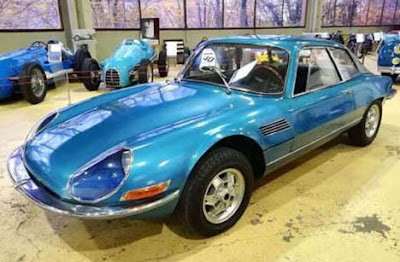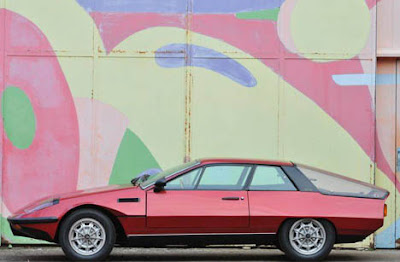Confusing ONES - Embarking on a journey through the captivating world of classic French automobiles unveils a trove of hidden treasures, especially those crafted by lesser-known manufacturers. Among these, the spotlight falls on Automobiles Marsonetto, a Lyon-based company founded by Mario Marsonetto in 1946. Despite its relatively short-lived presence in the automotive scene, spanning from 1957 to 1972, Marsonetto's creations have left an enduring mark, captivating enthusiasts with their unique and distinctive designs.
 |
| The Marsonetto 1600 GT of 1970s sported a more dynamic profile, attributed in part to its expansive liftback-style rear window.. (Picture from: DrivenToWrite) |
Mario Marsonetto, breaking away from his family's masonry trade, ardently pursued his automotive passion. Trained as a coachbuilder, Marsonetto honed his skills by rebodying cars, primarily Renaults and Citroëns, along with trucks. His expertise extended beyond mere bodyworking, encompassing the construction of supporting frames and other structural elements, laying the foundation for his future endeavors.
 |
| In 1957, Marsonetto debuted its inaugural car, the Luciole, based on the Panhard Dyna Z, offering two variants: Luxe and Rallye. (Picture from: AllCarIndex) |
In the late 1950s, Marsonetto succumbed to the allure of creating his own car, giving birth to the Luciole based on Panhard Dyna Z in 1957, and presented with 2 variants, Luxe and Rallye. Initially featuring aluminum bodywork, the Luciole later transitioned to fiberglass. Despite a modest fifteen Lucioles finding buyers, Marsonetto's automotive journey pressed on, leading him to establish an Alfa Romeo dealership after discontinuing Luciole production.
 |
| The Marsonetto Mars 1 at the time of its presentation at the Paris motor show in 1966. (Picture from: GTFrance.Free) |
The pivotal year 1965 marked a turning point as Marsonetto embarked on a new project, initially named Mars 1 and later rebranded as the 1600 GT. This 2+2 sports car, flaunting a fiberglass body on a tubular frame, showcased a more mature design compared to the Luciole. Drawing inspiration from the Jaguar E-Type at the front and elements reminiscent of Ferrari and Maserati, the 1600 GT made its official debut at the 1968 Geneva Motor Show, now powered by the Renault 16TS engine.
 |
| The Marsonetto 1600 GT (in the picture is the 1968 model) was an evolution of the Mars 1 whose architecture it adopted with a tubular chassis and polyester bodywork. (Picture from: LeDauphine) |
The 1968 Paris Motor Show witnessed the car's transformation into the 1600 GT, accompanied by rear styling changes, including a groundbreaking large glass opening rear hatch with a padded unzippable tonneau cover over the boot area. This innovative feature predated similar designs in the Porsche 924 and Renault Fuego by several years. The 1600 GT, heralded as a full four-seater, featured either round taillights or Renault 16 items, emphasizing Marsonetto's dedication to interior space.
 |
| The Marsonetto 1600 GT 2+2 sports coupe powered by an 1600 cc, four-cylinder drivetrain, boasting 92 horsepower and a 5-speed manual gearbox, propelled the car to a top speed of 200 km/h. (Picture from: DrivenToWrite) |
Continuing his automotive endeavors, Marsonetto introduced the R25-based four-seater GT sportscar in the 1970s, sharing the mechanical package of the earlier 1600 GT with Renault 16TS power and front-wheel drive. The 1600 cc, four-cylinder drivetrain, boasting 92 horsepower and a 5-speed manual gearbox, propelled the car to a top speed of 200 km/h.
 |
| The Marsonetto 1600 GT flaunting a fiberglass body on a tubular frame, showcased a more mature design. (Picture from: DrivenToWrite) |
 |
| The Marsonetto 1600 GT said as a full four-seater, accompanied by a unique rear styling, including a groundbreaking large glass opening rear hatch. (Picture from: DrivenToWrite) |
 With Marsonetto having ceased automotive operations, the whereabouts of these unique creations remain shrouded in mystery. Nonetheless, the enduring allure of Marsonetto's cars, immortalized in photographs, suggests the ongoing care and appreciation they continue to receive. Revisiting the legacy of Automobiles Marsonetto unveils a chapter of French automotive history characterized by innovation, distinctive design, and a passion that transcends generations. *** [EKA | FROM VARIOUS SOURCES | RAREFRENCHSPORTSCAR | ALL-ANDORA | CLASSICANDSPORTSCAR | DRIVENTOWRITE | CLASSIC AND RECREATION SPORTS CARS | LEDAUPHINE | GTFRANCE.FREE.FR ]
With Marsonetto having ceased automotive operations, the whereabouts of these unique creations remain shrouded in mystery. Nonetheless, the enduring allure of Marsonetto's cars, immortalized in photographs, suggests the ongoing care and appreciation they continue to receive. Revisiting the legacy of Automobiles Marsonetto unveils a chapter of French automotive history characterized by innovation, distinctive design, and a passion that transcends generations. *** [EKA | FROM VARIOUS SOURCES | RAREFRENCHSPORTSCAR | ALL-ANDORA | CLASSICANDSPORTSCAR | DRIVENTOWRITE | CLASSIC AND RECREATION SPORTS CARS | LEDAUPHINE | GTFRANCE.FREE.FR ]Note: This blog can be accessed via your smart phone.


 Logging you in...
Logging you in...